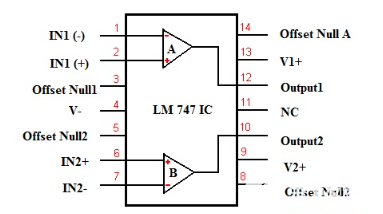The LM747 integrated circuit is a general purpose dual op-amp or operational amplifier, these amplifiers share a common bias network and lead to a power supply, the amplifiers operate completely independently of each other.
An additional feature of the LM747 mainly includes the fact that no blocking occurs when the input common mode range is exceeded, freedom from oscillation and packaging flexibility. In this article, a brief description of the LM747 IC data sheet is given, including pinout, circuit operation, specifications and application characteristics.
Pinout
The LM747 is a 14-pin dual op-amp device and the following explains the pin configuration descriptions for each pin in op-amp1 and op-amp2.

Pin4 (V-): Common negative voltage supply for both op-amps.
Pin11 (NC): no connection.
For op-amp 1.
Pin12 (1OUT): output pin of the first op-amp.
Pin1 (1 IN-): inverting input of the first op-amp.
Pin2 (1 IN+): in-phase input of the first op-amp.
Pin3 and 14 (Offset Null1): these pins are used to cancel the offset voltage and to balance the i/p voltage of the first op-amp.
Pin13 (V1+): positive voltage supply for the first op-amp.

For op-amp 2.
Pin6 (2IN+): in-phase input for the second op-amp.
Pin7 (2 IN-): inverting input of the second op-amp.
Pin10 (2OUT): output pin of the second op-amp.
Pin5 & 8 (Offset Null 2): this pin is used to cancel the offset voltage and to balance the input voltage of the second op-amp.
Pin9 (V2+): Positive voltage source for the second op-amp
The LM747C is available in a variety of package forms to suit your needs.
The LM747 IC equivalents include: LM747C, LM747E.
Alternatives to the LM747 IC include: LM158, LM358, LM4558, LM258, LM2904.
Specifications
The LM747 IC functional parameters include the following main points.
Short circuit protection
No latching
Low power utilisation
Very low noise intrusion between op-amps
No frequency compensation required
Large differential voltage and common mode range
Maximum supply voltage of ±22V
Differential input voltage of ±30V
Common-mode rejection ratio (CMRR) of 90dB
Operating temperature range of -55ºC to +125ºC
Overall power dissipation of 800mW
As mentioned above, the LM747 includes two general purpose operational amplifiers and the chip can be used to design any type of operational amplifier circuit, i.e. comparators, mathematical operations and other differential amplification. Furthermore, the two op-amps can perform two different functions at the same time. In addition, the IC includes offset pins to make the output more accurate in certain applications. A decade or so ago, this IC was more popular, but now there are several op-amp chips that are more sophisticated and efficient, so the LM747 model should be gradually replaced later on.
Application circuit
The LM747 circuit diagram is shown below, which uses two op-amps for the internal connections. These ICs are used to design most op-amp based circuits such as comparators, differential amplification, voltage followers and mathematical operations. The circuit can be built with a single op-amp for designing a simple preamplifier circuit using a microphone. In the circuit below, the op-amp acts as an in-phase amplifier.

The output signal from the microphone is connected to the op-amp for amplification just like the input. The cutting of the DC signal can be done from the microphone using the HPF, which can be formed by resistor R1 and capacitor C1 so that the amplified output can be heard from the small speaker connected to the output. Resistors R2 and R3 can form the feedback loop of an op-amp non-inverting amplifier.
The output equation is Vo = input voltage * gain
Vi x A = Vi x (1+R2/R3)
For example, consider a value of R2 = 1 megohm, R3 = 1 kilohm and an output voltage of 1mV from a microphone.
Then the output voltage Vo = 1m x (1+1000) = about 1 volt.
This voltage is displayed on the small speaker so that we can hear the sound. With this, an amplifier circuit based on an operational amplifier can also be designed and thus used to design different op-amp based applications.
Main applications
The main applications of the LM747 include the following
Analogue circuits
Amplifiers
Mathematical operations
Peak detectors
Measuring instruments
Voltage comparators
Summary
This is a brief introduction to the LM747 dual op-amp, which consists of two op-amps that have a bias network as well as a lead function to the power supply and whose main characteristic is that they do not latch up and do not oscillate as long as they are out of the input common mode range, so they were very widely used until earlier years.
